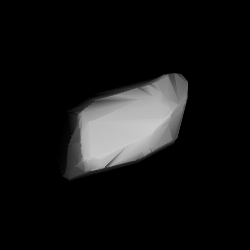244 Sita
Main-belt asteroid From Wikipedia, the free encyclopedia
244 Sita is a background asteroid from the inner region of the asteroid belt, approximately 11 kilometers (6.8 miles) in diameter.[1] It was discovered on 14 October 1884, by an Austrian astronomer Johann Palisa in the Vienna Observatory and was named for the Hindu deity Sita.[5]
 3D model based on lightcurve data | |
| Discovery | |
|---|---|
| Discovered by | Johann Palisa |
| Discovery date | 14 October 1884 |
| Designations | |
| (244) Sita | |
| Pronunciation | /ˈsiːtə/ |
Named after | Sita |
| A884 TA, 1900 UA 1957 KT, 1976 HY 1979 FL3 | |
| main-belt | |
| Orbital characteristics [1] | |
| Epoch 31 July 2016 (JD 2457600.5) | |
| Uncertainty parameter 0 | |
| Observation arc | 130.93 yr (47824 d) |
| Aphelion | 2.47317 AU (369.981 Gm) |
| Perihelion | 1.87531 AU (280.542 Gm) |
| 2.17424 AU (325.262 Gm) | |
| Eccentricity | 0.13749 |
| 3.21 yr (1,171.0 d) | |
| 46.3767° | |
| 0° 18m 26.737s / day | |
| Inclination | 2.84423° |
| 208.982° | |
| 166.029° | |
| Physical characteristics | |
| 10.95±0.8 km [1] 11 km [2] | |
| Mass | ~2×1015 (estimate) |
Mean density | ~2.7 g/cm3 (estimate) [3] |
| 129.51 h (5.396 d) | |
| 0.1941±0.033 [1] 0.194 [2] | |
| S [4] | |
| 11.9 | |
This minor planet is orbiting the Sun at a distance of 2.17 AU with an eccentricity of 0.137 and an orbital period of 3.21 yr. The orbital plane is tilted at an angle of 2.84° to the plane of the ecliptic.[1] It is spinning slowly, completing a rotation about its axis once every 129.056 ± 0.021 h (5.377 ± 0.001 d).[6]
References
External links
Wikiwand - on
Seamless Wikipedia browsing. On steroids.
